coolant SKODA ROOMSTER 2010 1.G User Guide
[x] Cancel search | Manufacturer: SKODA, Model Year: 2010, Model line: ROOMSTER, Model: SKODA ROOMSTER 2010 1.GPages: 231, PDF Size: 12.91 MB
Page 163 of 231
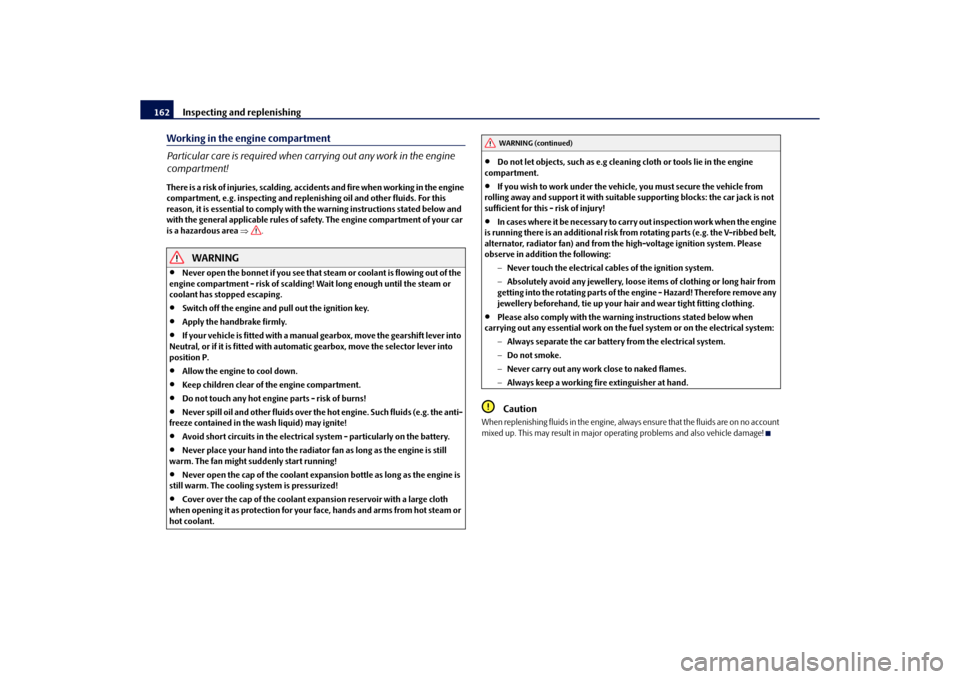
Inspecting and replenishing
162
Working in the engine compartment
Particular care is required when carrying out any work in the engine
compartment!There is a risk of injuries, scalding, acci dents and fire when working in the engine
compartment, e.g. inspecting and replenishing oil and other fluids. For this
reason, it is essential to comply with the warning instructions stated below and
with the general applicable rules of safe ty. The engine compartment of your car
is a hazardous area .
WARNING
Never open the bonnet if you see that steam or coolant is flowing out of the
engine compartment - risk of scalding! Wait long enough until the steam or
coolant has stopped escaping.
Switch off the engine and pull out the ignition key.
Apply the handbrake firmly.
If your vehicle is fitted with a manual gearbox, move the gearshift lever into
Neutral, or if it is fitted with automatic gearbox, move the selector lever into
position P.
Allow the engine to cool down.
Keep children clear of the engine compartment.
Do not touch any hot engine parts - risk of burns!
Never spill oil and other fluids over the hot engine. Such fluids (e.g. the anti-
freeze contained in the wash liquid) may ignite!
Avoid short circuits in the electrical system - particularly on the battery.
Never place your hand into the radiator fan as long as the engine is still
warm. The fan might suddenly start running!
Never open the cap of the coolant expans ion bottle as long as the engine is
still warm. The cooling system is pressurized!
Cover over the cap of the coolant expansion reservoir with a large cloth
when opening it as protection for your face, hands and arms from hot steam or
hot coolant.
Do not let objects, such as e.g cleaning cloth or tools lie in the engine
compartment.
If you wish to work under the vehicl e, you must secure the vehicle from
rolling away and support it with suitable supporting blocks: the car jack is not
sufficient for this - risk of injury!
In cases where it be necessary to carry out inspection work when the engine
is running there is an additional risk fr om rotating parts (e.g. the V-ribbed belt,
alternator, radiator fan) and from the high-voltage ignition system. Please
observe in addition the following:
Never touch the electrical cabl es of the ignition system.
Absolutely avoid any jewellery, loose it ems of clothing or long hair from
getting into the rotating parts of the engine - Hazard! Therefore remove any
jewellery beforehand, tie up your hair and wear tight fitting clothing.
Please also comply with the warnin g instructions stated below when
carrying out any essential work on the fuel system or on th e electrical system:
Always separate the car battery from the electrical system.
Do not smoke.
Never carry out any work close to naked flames.
Always keep a working fire extinguisher at hand.Caution
When replenishing fluids in the engine, always ensure that the fluids are on no account
mixed up. This may result in major oper ating problems and also vehicle damage!
WARNING (continued)
s16g.4.book Page 162 Wednesday, February 10, 2010 3:53 PM
Page 164 of 231
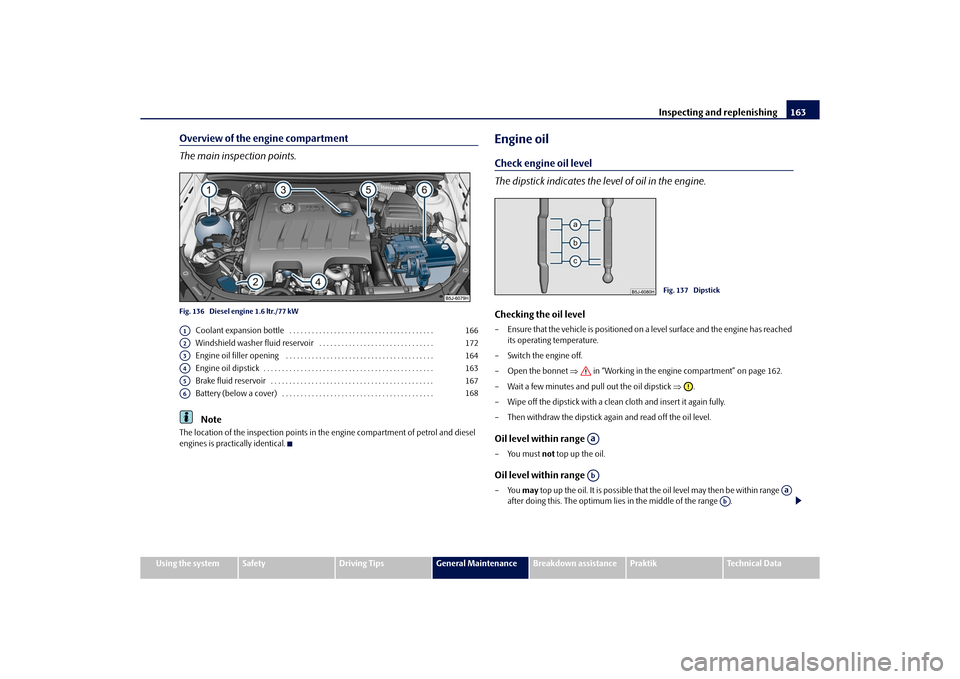
Inspecting and replenishing163
Using the system
Safety
Driving Tips
General Maintenance
Breakdown assistance
Praktik
Technical Data
Overview of the engine compartment
The main inspection points.Fig. 136 Diesel engine 1.6 ltr./77 kW
Coolant expansion bottle . . . . . . . . . . . . . . . . . . . . . . . . . . . . . . . . . . . . . . .
Windshield washer fluid reservoir . . . . . . . . . . . . . . . . . . . . . . . . . . . . . . .
Engine oil filler opening . . . . . . . . . . . . . . . . . . . . . . . . . . . . . . . . . . . . . . . .
Engine oil dipstick . . . . . . . . . . . . . . . . . . . . . . . . . . . . . . . . . . . . . . . . . . . . . .
Brake fluid reservoir . . . . . . . . . . . . . . . . . . . . . . . . . . . . . . . . . . . . . . . . . . . .
Battery (below a cover) . . . . . . . . . . . . . . . . . . . . . . . . . . . . . . . . . . . . . . . . .Note
The location of the inspection points in th e engine compartment of petrol and diesel
engines is practically identical.
Engine oilCheck engine oil level
The dipstick indicates the le vel of oil in the engine.Checking the oil level– Ensure that the vehicle is positioned on a level surface and the engine has reached
its operating temperature.
– Switch the engine off.
– Open the bonnet in “Working in the engine compartment” on page 162.
– Wait a few minutes and pull out the oil dipstick .
– Wipe off the dipstick with a clea n cloth and insert it again fully.
– Then withdraw the dipstick again and read off the oil level.Oil level within range –You must not top up the oil.Oil level within range –You may top up the oil. It is possible that the oil level may then be within range
after doing this. The optimum lies in the middle of the range .
A1
166
A2
172
A3
164
A4
163
A5
167
A6
168
Fig. 137 Dipstick
AaAb
Aa
Ab
s16g.4.book Page 163 Wednesda y, February 10, 2010 3:53 PM
Page 166 of 231
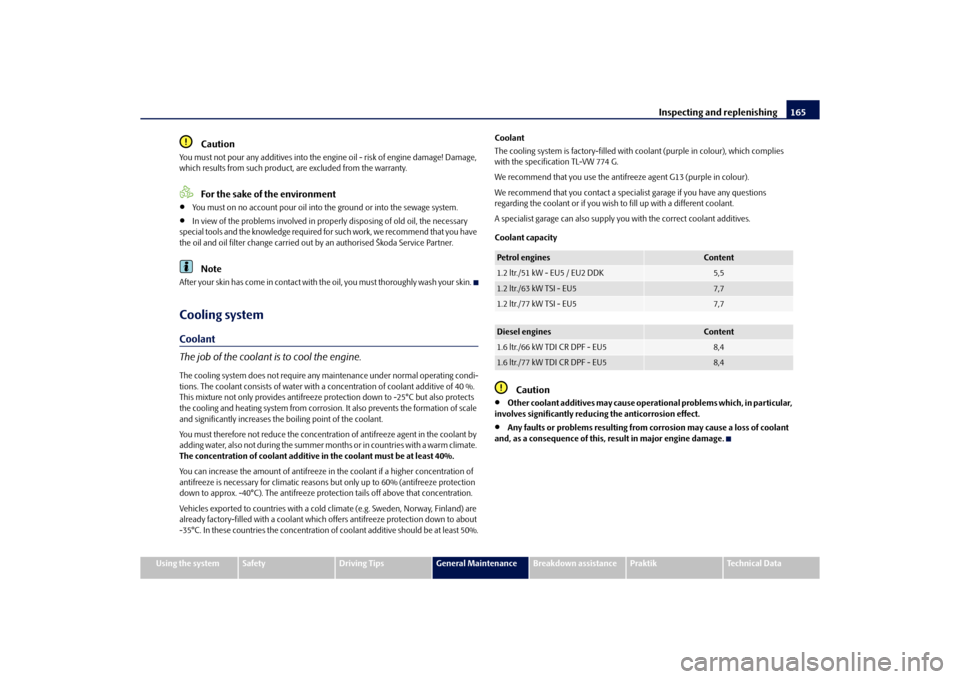
Inspecting and replenishing165
Using the system
Safety
Driving Tips
General Maintenance
Breakdown assistance
Praktik
Technical Data
Caution
You must not pour any additives into the en gine oil - risk of engine damage! Damage,
which results from such product, are excluded from the warranty.
For the sake of the environment
You must on no account pour oil into the ground or into the sewage system.
In view of the problems involved in prop erly disposing of old oil, the necessary
special tools and the knowledge required for such work, we recommend that you have
the oil and oil filter change carried out by an authorised Škoda Service Partner.Note
After your skin has come in contact with th e oil, you must thoroughly wash your skin.Cooling systemCoolant
The job of the coolant is to cool the engine.The cooling system does not require any maintenance under normal operating condi-
tions. The coolant consists of water with a concentration of coolant additive of 40 %.
This mixture not only provides antifreeze protection down to -25°C but also protects
the cooling and heating system from corrosion. It also prevents the formation of scale
and significantly increases the boiling point of the coolant.
You must therefore not reduce the concentration of antifreeze agent in the coolant by
adding water, also not during the summer mo nths or in countries with a warm climate.
The concentration of coolant additive in the coolant must be at least 40%.
You can increase the amount of antifreeze in the coolant if a higher concentration of
antifreeze is necessary for climatic reasons but only up to 60% (antifreeze protection
down to approx. -40°C). The antifreeze prot ection tails off above that concentration.
Vehicles exported to countries with a cold climate (e.g. Sweden, Norway, Finland) are
already factory-filled with a coolant which offers antifreeze protection down to about
-35°C. In these countries the concentration of coolant additive should be at least 50%. Coolant
The cooling system is factory-
filled with coolant (purple in colour), which complies
with the specification TL-VW 774 G.
We recommend that you use the antifr eeze agent G13 (purple in colour).
We recommend that you contact a specialist garage if you have any questions
regarding the coolant or if you wish to fill up with a different coolant.
A specialist garage can also supply you with the correct coolant additives.
Coolant capacity
Caution
Other coolant additives may cause operational problems which, in particular,
involves significantly reduci ng the anticorrosion effect.
Any faults or problems resulting from corrosion may cause a loss of coolant
and, as a consequenc e of this, result in major engine damage.Petrol engines
Content
1.2 ltr./51 kW - EU5 / EU2 DDK
5,5
1.2 ltr./63 kW TSI - EU5
7,7
1.2 ltr./77 kW TSI - EU5
7,7
Diesel engines
Content
1.6 ltr./66 kW TDI CR DPF - EU5
8,4
1.6 ltr./77 kW TDI CR DPF - EU5
8,4
s16g.4.book Page 165 Wednesda y, February 10, 2010 3:53 PM
Page 167 of 231
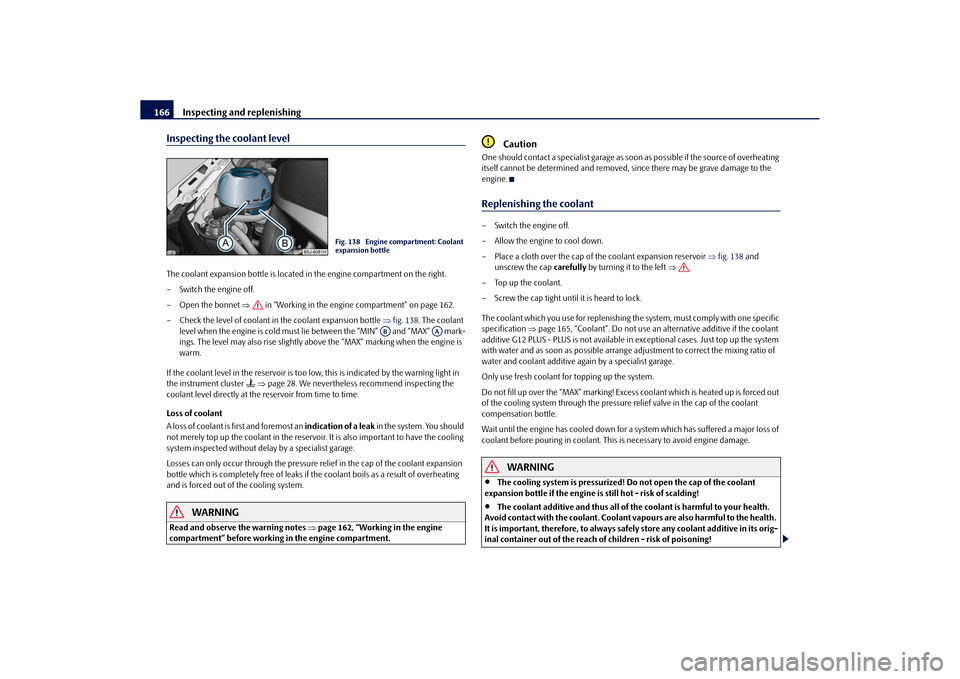
Inspecting and replenishing
166
Inspecting the coolant levelThe coolant expansion bottle is located in the engine compartment on the right.
– Switch the engine off.
– Open the bonnet in “Working in the engine compartment” on page 162.
– Check the level of coolant in the coolant expansion bottle fig. 138 . The coolant
level when the engine is cold must lie between the “MIN” and “MAX” mark-
ings. The level may also rise slightly above the “MAX” marking when the engine is
warm.
If the coolant level in the reservoir is too lo w, this is indicated by the warning light in
the instrument cluster
page 28. We nevertheless recommend inspecting the
coolant level directly at the reservoir from time to time.
Loss of coolant
A loss of coolant is first and foremost an indication of a leak in the system. You should
not merely top up the coolant in the reservoir. It is also important to have the cooling
system inspected without delay by a specialist garage.
Losses can only occur through the pressure relief in the cap of the coolant expansion
bottle which is completely free of leaks if the coolant boils as a result of overheating
and is forced out of the cooling system.
WARNING
Read and observe the warning notes page 162, “Working in the engine
compartment” before working in the engine compartment.
Caution
One should contact a specialist garage as s oon as possible if the source of overheating
itself cannot be determined and removed, since there may be grave damage to the
engine.Replenishing the coolant– Switch the engine off.
– Allow the engine to cool down.
– Place a cloth over the cap of the coolant expansion reservoir fig. 138 and
unscrew the cap carefully by turning it to the left .
–Top up the coolant.
– Screw the cap tight until it is heard to lock.
The coolant which you use for replenishing the system, must comply with one specific
specification page 165, “Coolant”. Do not use an al ternative additive if the coolant
additive G12 PLUS - PLUS is not available in exceptional cases. Just top up the system
with water and as soon as possible arrange adjustment to correct the mixing ratio of
water and coolant additive again by a specialist garage.
Only use fresh coolant for topping up the system.
Do not fill up over the “MAX” marking! Excess coolant which is heated up is forced out
of the cooling system through the pressure relief valve in the cap of the coolant
compensation bottle.
Wait until the engine has cooled down for a system which has suffered a major loss of
coolant before pouring in coolant. This is necessary to avoid engine damage.
WARNING
The cooling system is pressurized! Do not open the cap of the coolant
expansion bottle if the engine is still hot - risk of scalding!
The coolant additive and thus all of the coolant is harmful to your health.
Avoid contact with the coolant. Coolant vapours are also harmful to the health.
It is important, therefore, to always safely store any coolant additive in its orig-
inal container out of the reach of children - risk of poisoning!
Fig. 138 Engine compartment: Coolant
expansion bottle
AB
AA
s16g.4.book Page 166 Wednesda y, February 10, 2010 3:53 PM
Page 168 of 231
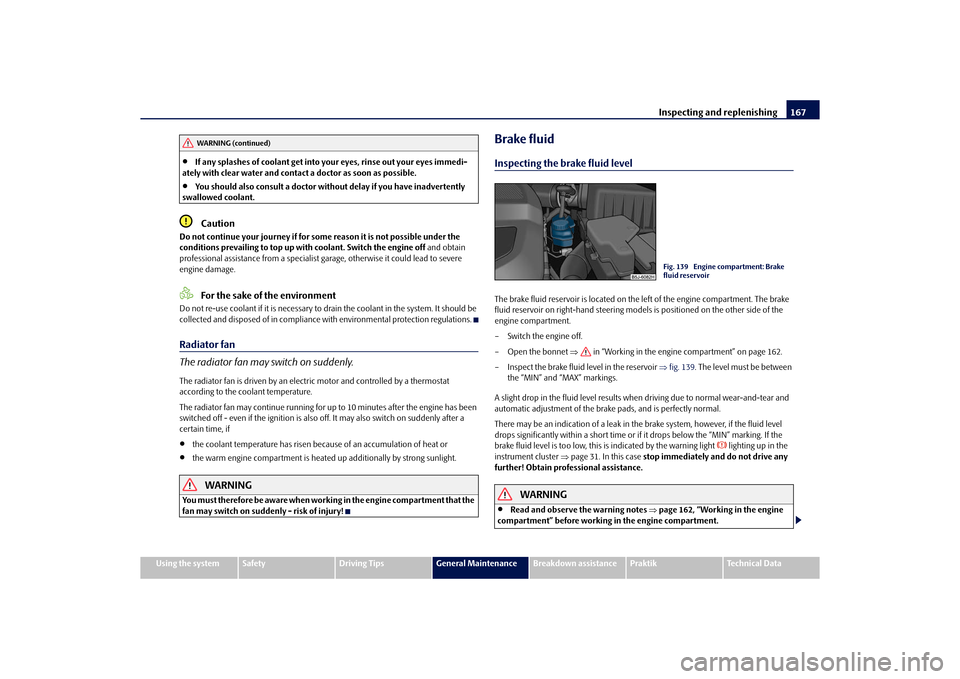
Inspecting and replenishing167
Using the system
Safety
Driving Tips
General Maintenance
Breakdown assistance
Praktik
Technical Data
If any splashes of coolant get into yo ur eyes, rinse out your eyes immedi-
ately with clear water and contact a doctor as soon as possible.
You should also consult a doctor without delay if you have inadvertently
swallowed coolant.Caution
Do not continue your journey if for some reason it is not possible under the
conditions prevailing to top up with coolant. Switch the engine off and obtain
professional assistance from a specialist garage, otherwise it could lead to severe
engine damage.
For the sake of the environment
Do not re-use coolant if it is necessary to drain the coolant in the system. It should be
collected and disposed of in compliance with environmental protection regulations.Radiator fan
The radiator fan may switch on suddenly.The radiator fan is driven by an electric motor and controlled by a thermostat
according to the coolant temperature.
The radiator fan may continue running for up to 10 minutes after the engine has been
switched off - even if the igni tion is also off. It may also switch on suddenly after a
certain time, if
the coolant temperature has risen beca use of an accumulation of heat or
the warm engine compartment is heated up additionally by strong sunlight.
WARNING
You must therefore be aware when workin g in the engine compartment that the
fan may switch on suddenly - risk of injury!
Brake fluidInspecting the brake fluid levelThe brake fluid reservoir is located on the left of the engine compartment. The brake
fluid reservoir on right-hand steering models is positioned on the other side of the
engine compartment.
– Switch the engine off.
– Open the bonnet in “Working in the engine compartment” on page 162.
– Inspect the brake fluid level in the reservoir fig. 139 . The level must be between
the “MIN” and “MAX” markings.
A slight drop in the fluid level results when driving due to normal wear-and-tear and
automatic adjustment of the brak e pads, and is perfectly normal.
There may be an indication of a leak in the brake system, however, if the fluid level
drops significantly within a short time or if it drops below the “MIN” marking. If the
brake fluid level is too low, this is indicated by the warning light
lighting up in the
instrument cluster page 31. In this case stop immediately and do not drive any
further! Obtain professional assistance.
WARNING
Read and observe the warning notes page 162, “Working in the engine
compartment” before working in the engine compartment.
WARNING (continued)
Fig. 139 Engine compartment: Brake
fluid reservoir
s16g.4.book Page 167 Wednesda y, February 10, 2010 3:53 PM
Page 193 of 231
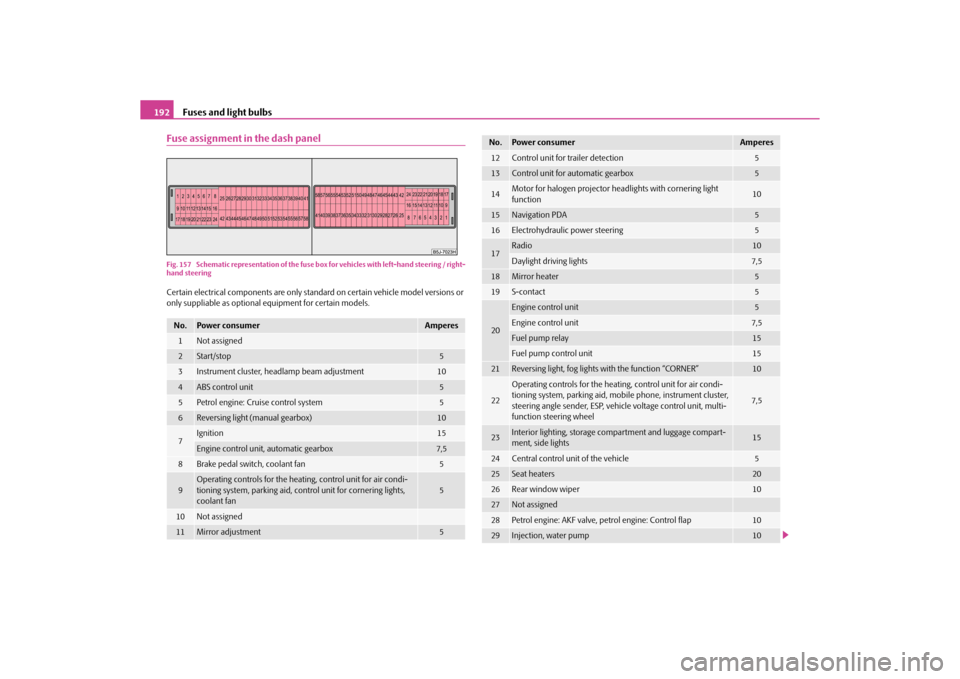
Fuses and light bulbs
192
Fuse assignment in the dash panelFig. 157 Schematic representation of the fuse box for vehicles with left-hand steering / right-
hand steeringCertain electrical components are only standard on certain vehicle model versions or
only suppliable as optional equipment for certain models.No.
Power consumer
Amperes
1
Not assigned
2
Start/stop
5
3
Instrument cluster, headlamp beam adjustment
10
4
ABS control unit
5
5
Petrol engine: Cruise control system
5
6
Reversing light (manual gearbox)
10
7
Ignition
15
Engine control unit, automatic gearbox
7,5
8
Brake pedal switch, coolant fan
5
9
Operating controls for the heating, control unit for air condi-
tioning system, parking aid, control unit for cornering lights,
coolant fan
5
10
Not assigned
11
Mirror adjustment
5
12
Control unit for trailer detection
5
13
Control unit for automatic gearbox
5
14
Motor for halogen projector headlights with cornering light
function
10
15
Navigation PDA
5
16
Electrohydraulic power steering
5
17
Radio
10
Daylight driving lights
7,5
18
Mirror heater
5
19
S-contact
5
20
Engine control unit
5
Engine control unit
7,5
Fuel pump relay
15
Fuel pump control unit
15
21
Reversing light, fog lights with the function “CORNER”
10
22
Operating controls for the heating, control unit for air condi-
tioning system, parking aid, mobi le phone, instrument cluster,
steering angle sender , ESP, vehicle voltage control unit, multi-
function steering wheel
7,5
23
Interior lighting, storage compartment and luggage compart-
ment, side lights
15
24
Central control unit of the vehicle
5
25
Seat heaters
20
26
Rear window wiper
10
27
Not assigned
28
Petrol engine: AKF valve, petrol engine: Control flap
10
29
Injection, water pump
10
No.
Power consumer
Amperes
s16g.4.book Page 192 Wednesda y, February 10, 2010 3:53 PM
Page 195 of 231
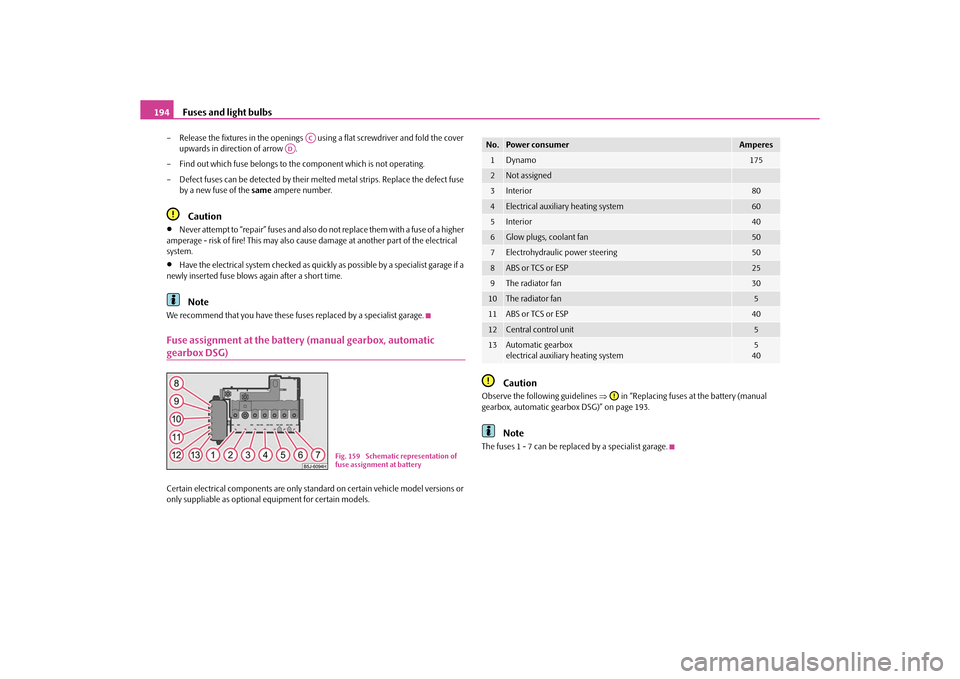
Fuses and light bulbs
194
– Release the fixtures in the openings using a flat screwdriver and fold the cover
upwards in direction of arrow .
– Find out which fuse belongs to th e component which is not operating.
– Defect fuses can be detected by their melted metal strips. Replace the defect fuse by a new fuse of the same ampere number.
Caution
Never attempt to “repair” fuses and also do not replace them with a fuse of a higher
amperage - risk of fire! This may also cause damage at an other part of the electrical
system.
Have the electrical system checked as quickl y as possible by a specialist garage if a
newly inserted fuse blows again after a short time.Note
We recommend that you have these fuses replaced by a specialist garage.Fuse assignment at the battery (manual gearbox, automatic gearbox DSG)Certain electrical components are only standard on certain vehicle model versions or
only suppliable as optional equipment for certain models.
Caution
Observe the following guidelines in “Replacing fuses at the battery (manual
gearbox, automatic gearbox DSG)” on page 193.
Note
The fuses 1 - 7 can be replac ed by a specialist garage.
AC
AD
Fig. 159 Schematic representation of
fuse assignment at battery
No.
Power consumer
Amperes
1
Dynamo
175
2
Not assigned
3
Interior
80
4
Electrical auxiliary heating system
60
5
Interior
40
6
Glow plugs, coolant fan
50
7
Electrohydraulic power steering
50
8
ABS or TCS or ESP
25
9
The radiator fan
30
10
The radiator fan
5
11
ABS or TCS or ESP
40
12
Central control unit
5
13
Automatic gearbox
electrical auxiliary heating system
5
40
s16g.4.book Page 194 Wednesda y, February 10, 2010 3:53 PM
Page 223 of 231
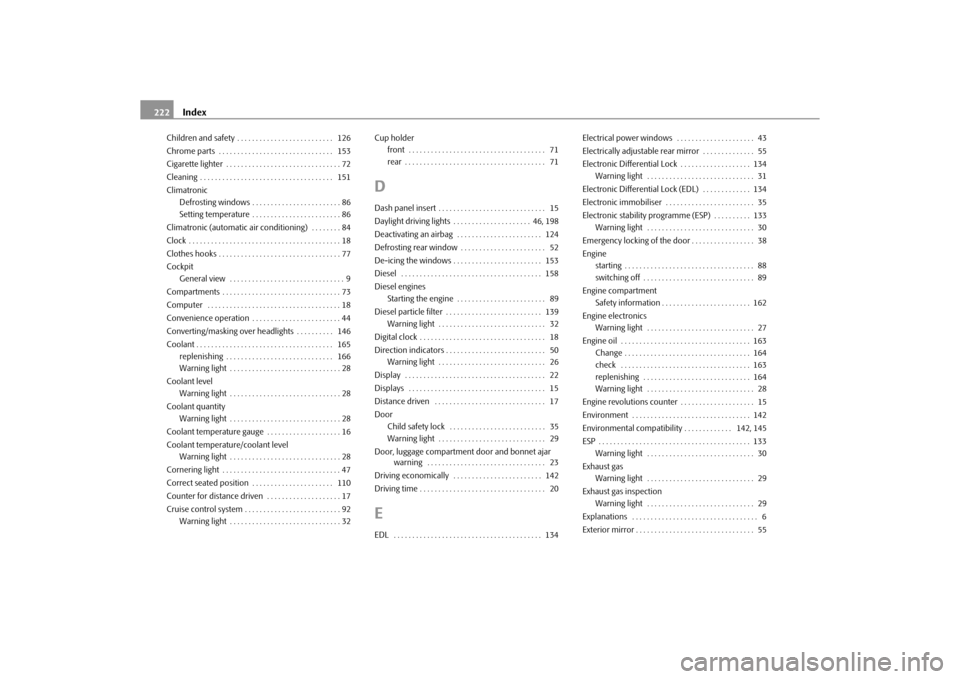
Index
222
Children and safety . . . . . . . . . . . . . . . . . . . . . . . . . . 126
Chrome parts . . . . . . . . . . . . . . . . . . . . . . . . . . . . . . . 153
Cigarette lighter . . . . . . . . . . . . . . . . . . . . . . . . . . . . . . . 72
Cleaning . . . . . . . . . . . . . . . . . . . . . . . . . . . . . . . . . . . . 151
Climatronic
Defrosting windows . . . . . . . . . . . . . . . . . . . . . . . . 86
Setting temperature . . . . . . . . . . . . . . . . . . . . . . . . 86
Climatronic (automat ic air conditioning) . . . . . . . . 84
Clock . . . . . . . . . . . . . . . . . . . . . . . . . . . . . . . . . . . . . . . . . 18
Clothes hooks . . . . . . . . . . . . . . . . . . . . . . . . . . . . . . . . . 77
Cockpit General view . . . . . . . . . . . . . . . . . . . . . . . . . . . . . . . 9
Compartments . . . . . . . . . . . . . . . . . . . . . . . . . . . . . . . . 73
Computer . . . . . . . . . . . . . . . . . . . . . . . . . . . . . . . . . . . . 18
Convenience operation . . . . . . . . . . . . . . . . . . . . . . . . 44
Converting/masking over headlights . . . . . . . . . . 146
Coolant . . . . . . . . . . . . . . . . . . . . . . . . . . . . . . . . . . . . . 165 replenishing . . . . . . . . . . . . . . . . . . . . . . . . . . . . . 166
Warning light . . . . . . . . . . . . . . . . . . . . . . . . . . . . . . 28
Coolant level Warning light . . . . . . . . . . . . . . . . . . . . . . . . . . . . . . 28
Coolant quantity Warning light . . . . . . . . . . . . . . . . . . . . . . . . . . . . . . 28
Coolant temperature gauge . . . . . . . . . . . . . . . . . . . . 16
Coolant temperature/coolant level Warning light . . . . . . . . . . . . . . . . . . . . . . . . . . . . . . 28
Cornering light . . . . . . . . . . . . . . . . . . . . . . . . . . . . . . . . 47
Correct seated position . . . . . . . . . . . . . . . . . . . . . . 110
Counter for distance driven . . . . . . . . . . . . . . . . . . . . 17
Cruise control system . . . . . . . . . . . . . . . . . . . . . . . . . . 92 Warning light . . . . . . . . . . . . . . . . . . . . . . . . . . . . . . 32 Cup holder
front . . . . . . . . . . . . . . . . . . . . . . . . . . . . . . . . . . . . . 71
rear . . . . . . . . . . . . . . . . . . . . . . . . . . . . . . . . . . . . . . 71
DDash panel insert . . . . . . . . . . . . . . . . . . . . . . . . . . . . . 15
Daylight driving lights . . . . . . . . . . . . . . . . . . . . . 46, 198
Deactivating an airbag . . . . . . . . . . . . . . . . . . . . . . . 124
Defrosting rear window . . . . . . . . . . . . . . . . . . . . . . . 52
De-icing the windows . . . . . . . . . . . . . . . . . . . . . . . . 153
Diesel . . . . . . . . . . . . . . . . . . . . . . . . . . . . . . . . . . . . . . 158
Diesel enginesStarting the engine . . . . . . . . . . . . . . . . . . . . . . . . 89
Diesel particle filter . . . . . . . . . . . . . . . . . . . . . . . . . . 139 Warning light . . . . . . . . . . . . . . . . . . . . . . . . . . . . . 32
Digital clock . . . . . . . . . . . . . . . . . . . . . . . . . . . . . . . . . . 18
Direction indicators . . . . . . . . . . . . . . . . . . . . . . . . . . . 50 Warning light . . . . . . . . . . . . . . . . . . . . . . . . . . . . . 26
Display . . . . . . . . . . . . . . . . . . . . . . . . . . . . . . . . . . . . . . 22
Displays . . . . . . . . . . . . . . . . . . . . . . . . . . . . . . . . . . . . . 15
Distance driven . . . . . . . . . . . . . . . . . . . . . . . . . . . . . . 17
Door Child safety lock . . . . . . . . . . . . . . . . . . . . . . . . . . 35
Warning light . . . . . . . . . . . . . . . . . . . . . . . . . . . . . 29
Door, luggage compartment door and bonnet ajar warning . . . . . . . . . . . . . . . . . . . . . . . . . . . . . . . . 23
Driving economically . . . . . . . . . . . . . . . . . . . . . . . . 142
Driving time . . . . . . . . . . . . . . . . . . . . . . . . . . . . . . . . . . 20EEDL . . . . . . . . . . . . . . . . . . . . . . . . . . . . . . . . . . . . . . . . 134 Electrical power windows . . . . . . . . . . . . . . . . . . . . . 43
Electrically adjustable rear mirror . . . . . . . . . . . . . . 55
Electronic Differential Lock . . . . . . . . . . . . . . . . . . . 134
Warning light . . . . . . . . . . . . . . . . . . . . . . . . . . . . . 31
Electronic Differential Lock (EDL) . . . . . . . . . . . . . 134
Electronic immobiliser . . . . . . . . . . . . . . . . . . . . . . . . 35
Electronic stability programme (ESP) . . . . . . . . . . 133 Warning light . . . . . . . . . . . . . . . . . . . . . . . . . . . . . 30
Emergency locking of the door . . . . . . . . . . . . . . . . . 38
Engine starting . . . . . . . . . . . . . . . . . . . . . . . . . . . . . . . . . . . 88
switching off . . . . . . . . . . . . . . . . . . . . . . . . . . . . . . 89
Engine compartment Safety information . . . . . . . . . . . . . . . . . . . . . . . . 162
Engine electronics Warning light . . . . . . . . . . . . . . . . . . . . . . . . . . . . . 27
Engine oil . . . . . . . . . . . . . . . . . . . . . . . . . . . . . . . . . . . 163 Change . . . . . . . . . . . . . . . . . . . . . . . . . . . . . . . . . . 164
check . . . . . . . . . . . . . . . . . . . . . . . . . . . . . . . . . . . 163
replenishing . . . . . . . . . . . . . . . . . . . . . . . . . . . . . 164
Warning light . . . . . . . . . . . . . . . . . . . . . . . . . . . . . 28
Engine revolutions counter . . . . . . . . . . . . . . . . . . . . 15
Environment . . . . . . . . . . . . . . . . . . . . . . . . . . . . . . . . 142
Environmental compatibility . . . . . . . . . . . . . 142, 145
ESP . . . . . . . . . . . . . . . . . . . . . . . . . . . . . . . . . . . . . . . . . 133 Warning light . . . . . . . . . . . . . . . . . . . . . . . . . . . . . 30
Exhaust gas Warning light . . . . . . . . . . . . . . . . . . . . . . . . . . . . . 29
Exhaust gas inspection Warning light . . . . . . . . . . . . . . . . . . . . . . . . . . . . . 29
Explanations . . . . . . . . . . . . . . . . . . . . . . . . . . . . . . . . . . 6
Exterior mirror . . . . . . . . . . . . . . . . . . . . . . . . . . . . . . . . 55
s16g.4.book Page 222 Wednesda y, February 10, 2010 3:53 PM